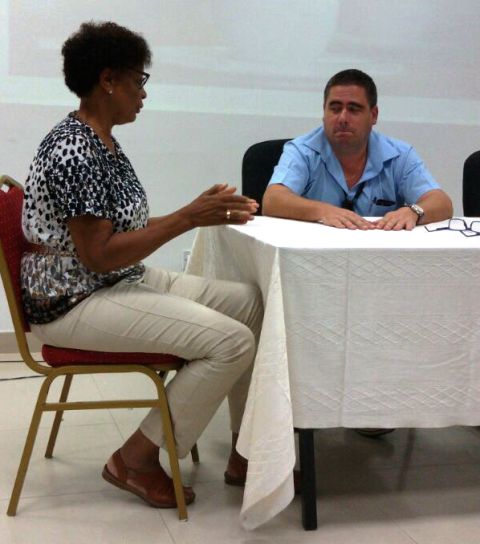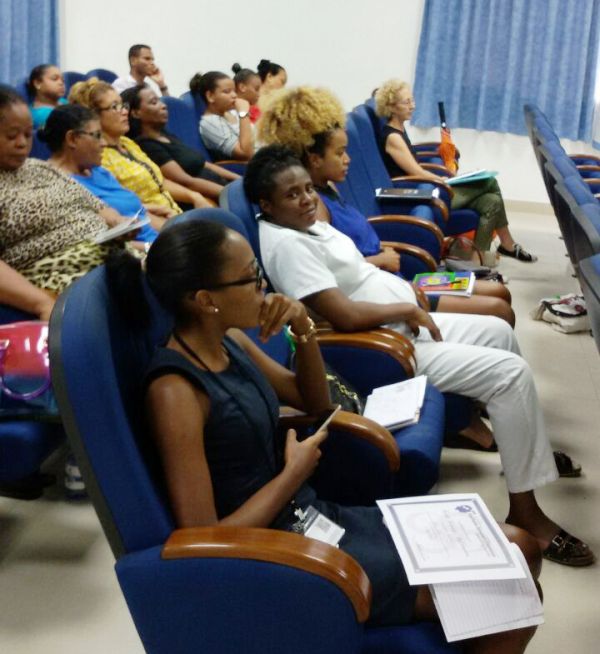Seychelles Hospital hosts 4th Seydementia workshop |23 May 2018

The 4th Seydementia workshop was held on May 16 at the Seychelles Hospital. Over 20 medical professionals, as well as some members of the Seychelles Alzheimer’s Foundation, attended the workshop.
Presenters Dr Rodrigues Lezcano and Samanta Servina did an excellent job of introducing the attendees to the basic concepts of dementia and its behavioural and psychiatric symptoms.
A clinical diagnostic test known as the Mini-Cog test was also described in detail.
The term dementia is derived from Latin to mean “out of one’s mind”. It is a syndrome of a chronic or progressive nature characterized by the deterioration of cognitive function (the ability to process thought). Dementia affects memory, thinking, orientation, comprehension, learning ability, language and judgment. The concept of dementia dates back to as early as 550 BC when Greek statesman and poet Solon made reference to the loss of judgment due to ageing. Since then, many philosophers and psychologists have expanded on this basic concept and developed their own theories, which either validated or denied their colleagues’ previous knowledge. The most significant discovery was that by Dr Alois Alzheimer in 1906, when he reported a patient with senile dementia and attributed them to unique plaque build-up and neurofibrillary tangles in elderly patients’ brains.
To date, Alzheimer’s disease stands as the most common type of dementia, accounting for more than 80% of dementia cases. In 2009, the number of dementia cases in the world was estimated at 35.6 million, a number that is expected to increase to 65 million in 2030 and to 113 million in 2050, of which two-thirds will live in developing countries.
According to Dr Lezcano, there are a few known risk factors for dementia. Hypertension, diabetes, stroke, obesity, low education and socio-economic status have been shown to contribute to the development of Alzheimer’s disease. On the other hand, there are protective factors against dementia such as physical activity, continuous cognitive stimulation (learning a new language, learning how to play a musical instrument, for example) and social interaction.

“It is essential that the Seychellois realise that a change in lifestyle is long overdue and that it can give them a second chance to live a healthier old age,” Dr Lezcano said.
He went on to say that for a country like the Seychelles, which has an ageing population and the health problems described above, the dementia syndrome has grown to become a major health concern. There is an urgent need for research to identify the people with dementia within the population of 65 years and above. A total of 95,843 people were registered as the population of Seychelles in the year 2017. An increase of the population average of those who were 65 years and above was observed at 9.6%, which today represents approximately 9,240 elderly persons in the Seychelles. If it is to be assumed that the population of Seychelles behaves similarly to the rest of the world’s population, such that one in ten people of this age would become ill with dementia, this would mean approximately 924 persons in the Seychelles already have it.
This is a reality we cannot deny and it is therefore important that if anyone has any suspicion of dementia in themselves or a member of their family, they should see a doctor who will refer them to the neurologist who will administer a few tests to determine if there are any signs of dementia or not. A typical test, as was described by Ms Servina in the workshop, consists of screening of cognitive abilities, a physical examination as well as looking at the patient’s medical history.
The Seychelles Alzheimer’s Foundation can also be contacted if anyone wishes to talk to someone about their concerns. Details of the SAF can be found in the accompanying logo.

BIBLIOGRAPHY
(1) Caixeta L, Costa JN, Vilela AC, Nóbrega M. The development of the dementia concept in 19th century. Arq Neuropsiquiatr. 2014 Jul;72(7):564-7.
(2) 10/66DementiaResearchGrou(2004). Carearrangementsforpeoplewithdementiain developing countries. IntJGeriatrPsychiatry, 19(2), 170-177.
(3) Alzheimer’s Association. 2017 Alzheimer’s Disease Facts and Figures. Alzheimers Dement 2017; 13:325-373.
(4)-Wilson RS, Segawa E, Boyle, PA, Anagnos SE, Hizel LP, Bennett DA. The natural history of cognitive decline in Alzheimer’s disease.Psychol Aging 2012;27(4):1008-17.
(5) Viswanathan A, Rocca WA, Tzourio C. Vascular risk factors and dementia: How to move forward? Neurology 2009;72:368-74.
(6) Barker WW, Luis CA, Kashuba A, Luis M, Harwood DG, Loewenstein D, et al. Relative frequencies of Alzheimer’s disease, Lewy body, vascular and frontotemporal dementia, and hippocampal sclerosis in the State of Florida Brain Bank. Alzheimer Dis AssocDisord 2002;16(4):203-12.
(7) Schneider JA, Arvanitakis Z, Bang W, Bennett DA. Mixed brain pathologies account for most dementia cases in community dwelling older persons. Neurology 2007;69:2197-204.




